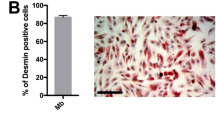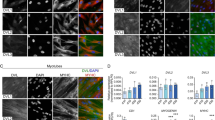Abstract
Several proteins that contribute to epigenetic mechanisms of gene regulation contain a characteristic motif of unknown function called the SET (Suvar3-9, Enhancer-of-zeste, Trithorax) domain. We have demonstrated that SET domains mediate highly conserved interactions with a specific family of proteins that display similarity with dual-specificity phosphatases (dsPTPases). These include myotubularin, the gene of which is mutated in a subset of patients with X-linked myotubular myopathy, and Sbf1, a newly isolated homologue of myotubularin. In contrast with myotubularin, Sbf 1 lacks a functional catalytic domain which dephosphorylates phospho-tyrosine and serine-containing peptides in vitro. Competitive interference of endogenous SET domain-dsPTPase interactions by forced expression of Sbf 1 induced oncogenic transformation of NIH 3T3 fibroblasts and impaired the in vitro differentiation of C2 myoblast cells. We conclude that myotubularin-type phosphatases link SET-domain containing components of the epigenetic regulatory machinery with signalling pathways involved in growth and differentiation.
This is a preview of subscription content, access via your institution
Access options
Subscribe to this journal
Receive 12 print issues and online access
$209.00 per year
only $17.42 per issue
Buy this article
- Purchase on SpringerLink
- Instant access to full article PDF
Prices may be subject to local taxes which are calculated during checkout
Similar content being viewed by others
References
Stassen, M.J. et al. The Drosophila trithorax proteins contain a novel variant of the nuclear receptor type DNA binding domain and an ancient conserved motif found in other chromosomal proteins. Mech. Dev. 52, 209–223 (1995).
Tschiersch, B. et al. The protein encoded by the Drosophila position-effect variegation suppressor gene Su(var)3-9 combines domains of antagonistic regulators of homeotic gene complexes. EMBO J. 13, 3822–3831 (1994).
Tkachuk, D.C., Kohler, S. & Cleary, M.L. Involvement of a homolog of Drosophila trithorax by 11q23 chromosomal translocations in acute leukemias. Cell 71, 691–700 (1992).
Gu, Y. et al. The t(4;11) chromosome translocation of human acute leukemias fuses the ALL1 gene, related to Drosophila trithorax, to the AF-4 gene. Cell 71, 701–708 (1992).
Djabali, M.L. et al. A trithorax-like gene is interrupted by chromosome 11q23 translocations in acute leukemia. Nature Genet. 2, 113–118 (1992).
Jones, R.S. & Gelbart, W.M., The Drosophila polycomb-group gene Enhancer of zeste contains a region with sequence similarity to trithorax. Mol. Cell. Biol. 13, 6357–6366 (1993).
Kennison, J.A. & Tamkun, J.W. Dosage-dependent modifiers of polycomb and antennapedia mutations in Drosophila. Proc. Natl. Acad. Sci. USA 85, 8136–8140 (1988).
Kennison, J.A., Polycomb and trithorax group proteins of Drosophila: trans-regulators of homeotic gene function. Annu. Rev. Genet. 29, 289–303 (1995).
Paro, R. Imprinting a determined state into the chromatin of Drosophila. Trends Genet. 6, 416–421 (1990).
Pirotta, V. PcG complexes and chromatin silencing. Curr. Opin. Genet. Dev. 7, 249–258 (1997).
Tripoulas, N., LaJeunesse, D., Gildea, J. & Shearn, A., The Drosophila ash1 gene product, which is localized at specific sites on polytene chromosomes, contains a SET domain and a PHD finger. Genetics 143, 913–928 (1996).
Chinwalla, V., Jane, E.P. & Harte, P.J., The Drosophila trithorax protein binds to specific chromosomal sites and is co-localized with Polycomb at many sites. EMBO J. 14, 2056–2065 (1995).
Rastelli, L., Chan, C.S. & Pirotta, V. Related chromosome binding sites for zeste, suppressors of zeste and Polycomb group proteins in Drosophila and their dependence on Enhancer of zeste function. EMBO J. 12, 1513–1522 (1993).
Yu, B.D. et al. Altered Hox expression and segmental identity in MLL-mutant mice. Nature 378, 505–508 (1995).
Nislow, C., Ray, E. & Pillus, L. SET1, a yeast member of the Trithorax family, functions in transcriptional silencing and diverse cellular processes. Mol. Biol. Cell 8, 2421–2436 (1997).
Laible, G. et al. Mammalian homologues of the Polycombgroup gene Enhancer of Zeste mediate gene silencing in Drosophila heterochromatin and at S. cerevisiaetelomeres. EMBO J. 16, 3219–3232 (1997).
Laporte, J. et al. A gene mutated in X-linked myotubular myopathy defines a new putative tyrosine phosphatase family conserved in yeast. Nature Genet. 13, 175–182 (1996).
Fischer, E.H., Charbonneau, H. & Tonks, N.K. Protein tyrosine phosphatases: a diverse family of intracellular and transmembrane enzymes. Science 253, 401–406 (1991).
Butler, L.H. et al. The HRX proto-oncogene product is widely expressed in human tissues and localises to nuclear structures. Blood, 89, 3361–3370 (1997).
Rohan, P.J. et al. PAC-1: A mitogen-induced nuclear protein tyrosine phosphatase. Science 259, 1763–1766 (1993).
Sun, H. et al. MKP-1 (3CH134), an immediate early gene product, is a dual specificity phosphatase that dephosphorylates MAP kinase in vivo. Cell 75, 487–493 (1993).
Ward, Y. et al. Control of MAP kinase activation by the mitogen-induced threonine/tyrosine phosphatase PAC1. Nature 367, 651–654 (1994).
Streuli, M. Protein tyrosine phosphatases in signaling. Curr. Opin. Cell Biol. 8, 182–188 (1996).
Rost, B. & Sander, C. Combining evolutionary information and neural networks to predict protein secondary structure. Proteins 19, 55–72 (1994).
Denu, J.M. et al. Visualization of intermediate and transition-state structures in protein-tyrosine phosphatase catalysis. Proc. Natl. Acad. Sci. USA 93, 2493–2498 (1996).
Barford, D., Flint, A.J. & Tonks, N.K. Crystal structure of human protein tyrosine phosphatase 1B. Science 263,1397–1404 (1994).
Yuvaniyama, J. et al. Crystal structure of the dual specificity protein phosphatase VHR. Science 272, 1328–1331 (1996).
Guan, K.L. & Dixon, J.E. Evidence for protein-tyrosine-phosphatase catalysis proceeding via a cysteine-phosphate intermediate. J. Biol. Chem. 266, 17026–17030 (1991).
Wishart, M.J. et al. A single mutation converts a novel phosphotyrosine binding domain into a dual-specificity phosphatase. J. Biol. Chem. 270, 26782–26785 (1995).
Denu, J.M. et al. Form and function in protein dephosphorylation. Cell 87, 361–364 (1996).
Galaktionov, K. et al. CDC25 phosphatases as potential human oncogenes. Science 269, 1575–1577 (1995).
Li, J. et al. PTEN, a putative protein tyrosine phosphatase gene mutated in human brain, breast and prostate cancer. Science 275, 1943–1947 (1997).
Steck, P.A. et al. Identification of a candidate tumour suppressor gene, MMAC1, at chromosome 10q23.3 that is mutated in multiple advanced cancers. Nature Genet. 15, 356–362 (1997).
Liaw, D. et al. Germline mutations of the PTEN gene in Cowden disease, an inherited breast and thyroid cancer syndrome. Nature Genet. 16, 64–67 (1997).
Carton, A.J., Flint, A.J. & Tonks, N.K. Identification of p130(cas) as a substrate for the cytosolic protein tyrosine phosphatase PTP-PEST. Mol. Cell. Biol. 16, 6408–6418 (1996).
Flint, A.J., Tiganis, T., Barford, D. & Tonks, N.K. Development of ‘substrate trapping’ mutants to identify physiological substrates of protein tyrosine phosphatases. Proc. Natl. Acad. Sci. USA 94, 1680–1685 (1997).
Waring, P.M. & Cleary, M.L. Disruption of a homolog of trithorax by 11q23 translocations: Leukemogenic and transcriptional implications. Curr. Top. Microbiol. Immunol. 220, 1–23 (1997).
Lavau, C., Szilvassy, S., Slany, R. & Cleary, M.L. Immortalization and leukemic transformation of a myelomonocytic precursor by retrovirally transduced HRX-ENL. EMBO J. 16, 4226–4237 (1997).
Slany, R., Lavau, C. & Cleary, M.L. The oncogenic capacity of HRX-ENL requires the transcriptional transactivation activity of ENL and the DNA binding motifs of HRX. Mol. Cell. Biol. 18, 122–129 (1998).
Zhou, G. et al. The catalytic role of Cys124 in the dual specificity phosphatase VHR. J. Biol. Chem. 269, 28284–28090 (1994).
Baskaran, R., Dahmas, M.E. & Wang, J.Y. Tyrosine phosphorylation of mammalian RNA polymerase II carboxyl-terminal domain. Proc. Natl. Acad. Sci. USA 90,11167–11171 (1993).
Streuli, M. et al. A family of receptor-linked protein tyrosine phosphatases in humans and Drosophila. Proc. Natl. Acad. Sci. USA 86, 8698–8702 (1989).
Author information
Authors and Affiliations
Rights and permissions
About this article
Cite this article
Cui, X., Vivo, I., Slany, R. et al. Association of SET domain and myotubularin-related proteins modulates growth control. Nat Genet 18, 331–337 (1998). https://doi.org/10.1038/ng0498-331
Received:
Accepted:
Issue Date:
DOI: https://doi.org/10.1038/ng0498-331



